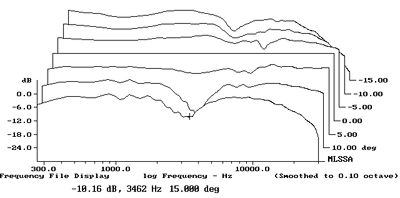| Columns Retired Columns & Blogs |
RBH 641-SE loudspeaker Measurements part 2
I was puzzled enough by this to check the internal wiring of both speakers of the pair. Momentarily touching a 1.5V dry-cell battery to the binding posts caused the cones of the woofers and midrange unit initially to move outward with the in-phase connection. Yet this connection resulted in the measured 200Hz notch. Peculiar. It looks as though the designer has not taken into account the phase shift associated with the crossover filters.
Fig.5 shows the 641-SE's lateral dispersion normalized to the HF-axis response. The suckout associated with the lower crossover makes its presence known by deepening to the sides, but apart from that, the RBH's radiation pattern is wide and even up to 8kHz or so. Above that frequency, the speaker becomes quite directional, which, as I heard, will result in a lack of top-octave air in all but very lively rooms. In the vertical plane (fig.6), a big suckout develops in the upper crossover region for very low listening angles, but the flat tweeter-axis response otherwise appears to be maintained at a wide range of listener heights. In my auditioning, however, I felt the treble balance sounded most integrated when I kept my ears below the top of the cabinet, in the region of the 36.5"-high tweeter axis.

Fig.5 RBH 641-SE, lateral response family at 50", normalized to response on tweeter axis, from back to front: differences in response 90 degrees-5 degrees off-axis, reference response, differences in response 5 degrees-90 degrees off-axis.

Fig.6 RBH 641-SE, vertical response family at 50", normalized to response on tweeter axis, from back to front: differences in response 15 degrees-5 degrees above axis, reference response, differences in response 5 degrees-15 degrees below axis.
Fig.7 shows how these quasi-anechoic responses sum in my room, with the microphone placed in 20 different positions in a grid centered on the listening position for left and right speakers individually. The red trace is with the woofers wired "correctly," in-phase, and the black with jumpers connecting the red woofer terminal to the black midrange terminal, and vice versa. Note that this does result in more lower-midrange energy at the listening position, but that neither this improvement nor the suckout in the in-phase condition are as large as might be expected from the anechoic behavior shown in fig.4. This is both because the nominal on-axis cancellation doesn't necessarily happen at all off-axis angles—the same amount of energy is being put into the room in both conditions—and because it is obscured by room effects (such as the 641-SE's "floor-bounce" cancellation) in the same frequency region. But note how smooth the RBH's upper-frequency behavior is in my room, correlating with my impression of a neutral balance, and how the bass is, in general, somewhat shelved-down.

Fig.7 RBH 641-SE, spatially averaged, 1/3-octave, freefield response in JA's listening room. Red trace is with woofers wired in phase; black trace is with them wired out of phase.
In the time domain, the 641-SE's step response on the tweeter axis (fig.8) indicates that all four drive-units are connected in the same positive acoustic polarity. But if you look at the individual step responses of the midrange unit and woofers (fig.9), you can see that the slower rise of the woofer step results in its output being out of phase with the midrange unit's, even though both initially move away from the time axis in the same direction. Yes, the woofers' output will be delayed a little, due to it being farther way than the midrange unit from the farfield listening position. However, it needs to be around 4' away to bring its output into time-coincidence with that of the midrange unit.

Fig.8 RBH 641-SE, on-axis step response at 50" (5ms time window, 30kHz bandwidth).

Fig.9 RBH 641-SE, nearfield step responses of midrange unit (red) and woofers (blue). (25ms time window, 1kHz bandwidth)
Finally, the RBH 641-SE's farfield waterfall plot (fig.10) is superbly clean, correlating with the absence of high-frequency grain that impressed me in my auditioning.—John Atkinson

Fig.10 RBH 641-SE, cumulative spectral-decay plot at 50" (0.15ms risetime).
- Log in or register to post comments




































